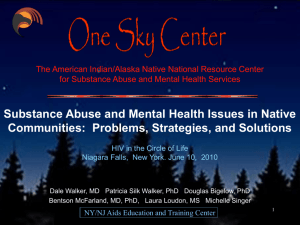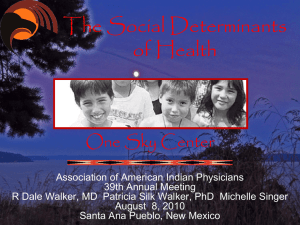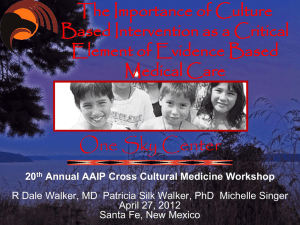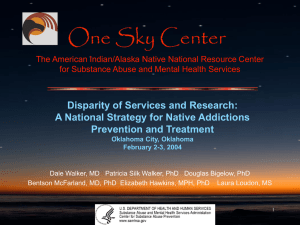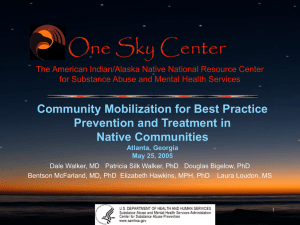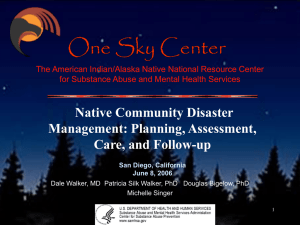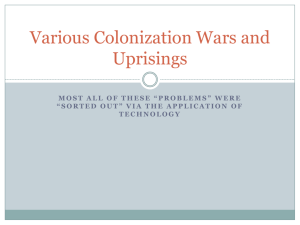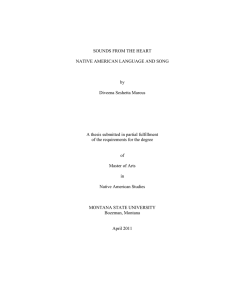Providing Behavioral Health Care in Native
advertisement
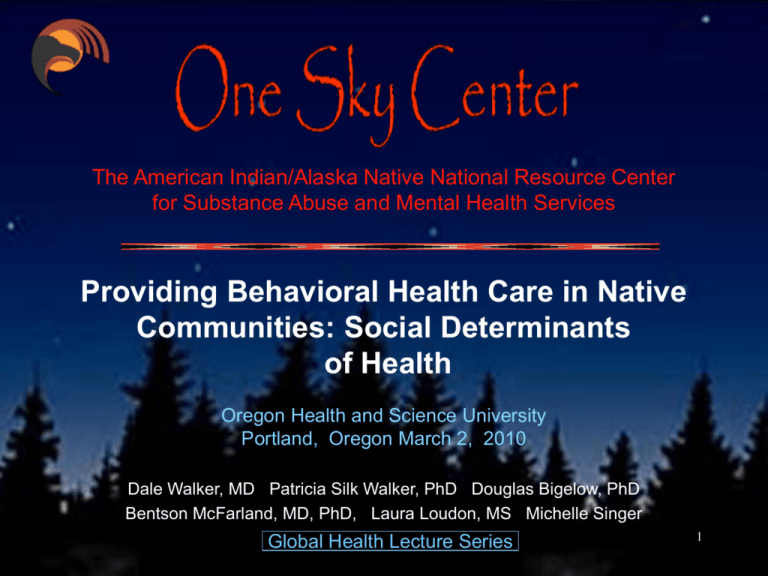
The American Indian/Alaska Native National Resource Center for Substance Abuse and Mental Health Services Providing Behavioral Health Care in Native Communities: Social Determinants of Health Oregon Health and Science University Portland, Oregon March 2, 2010 Dale Walker, MD Patricia Silk Walker, PhD Douglas Bigelow, PhD Bentson McFarland, MD, PhD, Laura Loudon, MS Michelle Singer Global Health Lecture Series 1 One Sky Center 2 One Sky Center Partners Cook Inlet Tribal Council Alaska Native Tribal Health Consortium Northwest Portland Area Indian Health Board Tribal Colleges and Universities Prairielands ATTC Red Road One Sky Center United American Indian Involvement Harvard Native Health Program Jack Brown Adolescent Treatment Center National Indian Youth Leadership Project Tri-Ethnic Center for Na'nizhoozhi Center Prevention Research 3 One Sky Center Outreach 4 Goals for Today • • • • • • Define Social Determinants of Health Review An Environmental Scan for Natives Discuss Fragmentation and Integration Present Some Behavioral Health Care Issues Present Examples of Treatment and Prevention Summarize Critical Issues for Native Peoples 5 The Social Determinants of Health • The conditions in which people are born, grow, live, work and age. • Shaped by the distribution of money, power and resources at global, national and local levels. • Are mostly responsible for health inequities the unfair and avoidable differences in health status seen within and between countries. 6 Social Determinants of Health • Ubiquitous • Powerful influence on health • Underlie: – Differences between individuals within countries – Differences between groups, populations and countries – Changes in health over time • Complex pathways WHO Social Determinant Themes • • • • • • • • • Social exclusion Urbanization Globalization Health systems Priority public health conditions Early child development Women and gender equity Employment conditions Measurement and evidence 8 WHO ARE INDIGENOUS PEOPLES? “Indigenous peoples remain on the margins of society: they are poorer, less educated, die at a younger age, are much more likely to commit suicide, and are generally in worse health than the rest of the population." (Source: The Indigenous World 2006, International Working Group on Indigenous Affairs (IWGIA) WHO 9 INDIGENOUS PEOPLE WORLD MAP - 370 million indigenous peoples living in more than 70 countries 10 11 12 13 14 Native Health Issues 1. 2. 3. 4. 5. 6. 7. 8. Alcoholism 6X Tuberculosis 6X Diabetes 3.5 X Accidents 3X Poverty 3x Depression 3x Suicide 2x Violence? 1. Same disorders as general population 2. Greater prevalence 3. Greater severity 4. Much less access to Tx 5. Cultural relevance more challenging 6. Social context disintegrated 15 Native Healthcare Resource Disparities 16 Agencies Involved in B.H. Delivery 1. Indian Health Service (IHS) A. Mental Health B. Primary Health C. Alcoholism / Substance Abuse 2. Bureau of Indian Affairs (BIA) A. Education B. Vocational C. Social Services D. Police 3. Tribal Health 4. Urban Indian Health 5. State and Local Agencies 6. Federal Agencies: SAMHSA, VAMC, Justice 17 Different goals Resource silos One size fits all Activity-driven How are we functioning? (Carl Bell and Dale Walker 7/03) 18 Culturally Specific Best Practice Outcome Driven Integrating Resources We need Synergy and an Integrated System (Carl Bell and Dale Walker 7/03) 19 Behavioral Health Care Issues 20 Adult Serious Mental Illness By Race/Ethnicity: 2001 SAMHSA Office of Applied Studies, 2001 21 Frequent Mental Distress by Race/Ethnicity and Year Percent American Indian/ Alaskan Native** African-American** Hispanic White** Asian, Pacific Islander** ** Non-Hispanic Year * Zahran HS, et al. Self-Reported Frequent Mental Distress Among Adults — United States, 1993–2001. Centers for Disease Prevention and Control, 22 MMWR 2004;53(41):963-966. Mental Illness: A Multi-factorial Event Psychiatric Illness & Stigma Edu., Econ., Rec. Cultural Distress Impulsiveness Substance Use/Abuse Family Disruption/ Domestic Violence Individual Negative Boarding School Historical Trauma Hopelessness Family History Psychodynamics/ Psychological Vulnerability Suicidal Behavior 23 Key Adolescent Risk Factors Aggressive/Impulsive Substance Abuse Depression Trauma 24 Six behaviors that contribute to serious health problems: • • • • Tobacco use Poor nutrition Alcohol and other drug abuse Behaviors resulting in intentional or unintentional injury • Physical inactivity • Risky sex http://www.cdc.gov/HealthyYouth/healthtopics/index.htm Suicide Among ages 15-17, 2001 Death rate per 100,000 16 14 12 10 8 6 4 2010 Target 2 00 Total Females Males Source: National Vital Statistics System - Mortality, NCHS, CDC. 26 Suicide: A Native Crisis AI Male Black Male AI Female 50 40 30 20 Age Groups 27 Source: National Center for Health Statistics 2001 85+ 80-84 75-79 70-74 65-69 60-64 55-59 50-54 45-49 40-44 35-39 30-34 25-29 20-24 15-19 0 10-14 10 5-9 Rate/100,000 . 60 White Male 28 North Dakota Teen Suicide Rates (2000-2004 rate per 100,000 teens 13-19 years old) 29 Disaster Defined • FEMA: A natural or man-made event that negatively affects life, property, livelihood or industry often resulting in permanent changes to human societies, ecosystems and environment. • NHTSA: Any occurrence that causes damage, ecological destruction, loss of human lives, or deterioration of health and health services on a scale sufficient to warrant an extraordinary response from outside the affected community area. • NOAA: A crisis event that surpasses the ability of an individual, community, or society to control or recover from its consequences. 30 Models of Care 31 Domains Influencing Behavioral Health: A Native Ecological Model Risk Individual Protection Peers/Family Community/Tribe Society/Cultural 32 Spectrum of Intervention Responses Thresholds for Action No Problems Mild Problems Moderate Problems Severe Problems Treatment Brief Intervention Universal/Selective Prevention 33 The Intervention Spectrum for Behavioral Disorders Case Identification Standard Treatment for Known Indicated— Disorders Diagnosed Youth Selective— Health Risk Groups Universal— General Population Compliance with Long-Term Treatment (Goal:Reduction in Relapse and Recurrence) Aftercare (Including Rehabilitation) Source: Mrazek, P.J. and Haggerty, R.J. (eds.), Reducing Risks for Mental Disorders, Institute of Medicine, Washington, DC: National Academy Press, 1994. 34 Risk and Protective Factors: Individual Risk Mental illness Age/gender Substance abuse Loss Previous suicide attempt Personality traits Incarceration Failure/academic problems Protective Cultural/religious beliefs Coping/problem solving skills Ongoing health and mental health care Resiliency, self esteem, direction, mission, determination, perseverance, optimism, empathy Intellectual competence, reasons for living 35 Individual Intervention • Identify risk and protective factors counseling skill building improve coping support groups • Increase community awareness • Access to hotlines other help resources 36 Effective Interventions for Adults • • • • • • • • • Cognitive/Behavioral Approaches Motivational Interventions Psychopharmacological Interventions Modified Therapeutic Communities Assertive Community Treatment Vocational Services Dual Recovery/Self-Help Programs Consumer Involvement Therapeutic Relationships 37 Culture-Based Interventions • • • • • • • • • • Story telling Sweat Lodge Talking circle Vision quest Wiping of tears Drumming Smudging Traditional Healers Herbal remedies Traditional activities 38 Definition: Indigenous Knowledge • Local knowledge unique to a given culture or society; it has its own theory, philosophy, scientific and logical validity, used as a basis for decision-making for all of life’s needs. 39 Definitions: Traditional Medicine • The sum total of health knowledge, skills and practices based upon theories, beliefs and experiences indigenous to different cultures…used in the maintenance of health. WHO 2002 40 ID Best Practice Best Practice Clinical/services Research Mainstream Practice Traditional Medicine 41 What are some promising strategies? 42 An Ideal Intervention • Broadly based: Includes individual, family, community, tribe, and society • Comprehensive: Prevention: Universal, Selective, Indicated Treatment Maintenance 43 Choctaw Nation of Oklahoma • • • • • • • • Adventure Therapy “Natural Highs Program” Transformation process Experiential activities Relationship building Changing the way you live and think Changing how you think and how you believe about life and yourself Creation of challenge in a safe environment Horses, Canoes, Tradition Camps 44 Meth Free Crow Walk: Youth as our Warriors in Reclaiming our Nation Meth Free Crowalition • Establish a “War Against Meth” Focus on accountability, prevention, intervention, and treatment • Combine forces for Unity. • Diverse community representation • Youth and Community Development: mentorship, leadership, trust, establish community norms 45 Integrated Treatment Premise: treatment at a single site, featuring coordination of treatment philosophy, services and timing of intervention will be more effective than a mix of discrete and loosely coordinated services Findings: • decrease in hospitalization • lessening of psychiatric and substance abuse severity • better engagement and retention (Rosenthal et al, 1992, 1995, 1997; Hellerstein et al 1995.) 46 Comprehensive School Planning • • • • • • • • • Prevention and behavioral health programs/services on site Handling behavioral health crises Responding appropriately and effectively after an event Public awareness and media campaigns Youth Development Services Social Interaction Skills Training Approaches Mentoring Tutoring Rites of Passage 47 Partnered Collaboration State/Federal Grassroots Groups Community-Based Organizations Research-Education-Treatment 48 Six Key Principles Evidence-based predictors of change • • • • • • Leadership Mobilization Community driven Public health approach Strength based Culturally informed Proactive 49 Critical Elements for Native Peoples • • • • • • • • • Self determination Ecology and environment Economic prosperity, fairness and equity Leadership and capacity strengthening Racism / dominance / imperialism Healing, services, systems, structures Cultural sustainability, protection, stewardship Land Human rights 50 Areas for Action Health Equity in all Policies Good Global Governance Fair Financing Market Responsibility Early child development and education Healthy Places Fair Employment Social Protection Universal Health Care Gender Equity Political empowerment – inclusion and voice NIDA American Indian Research Scholars Mentorship Program 52 Location of Mentors = and Mentees = in Project X X X X X X X X X 53 Contact us at 503-494-3703 E-mail Dale Walker, MD onesky@ohsu.edu Or visit our website: www.oneskycenter.org 20 54
